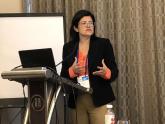News

Having unmet social needs ups cardiovascular risk
WASHINGTON – Food and transportation for patients need to be addressed to help patients decrease their cardiovascular risks.
Charlie Wray is an Internist in the Division of Hospital Medicine; Marzieh Vali is a Statistician in the Northern California Institute for Research and Education; Louise Walter is a Geriatrician in the Division of Geriatrics; and Salomeh Keyhani is an Internist in the Division of General Internal Medicine; all at the San Francisco Veterans Affairs Medical Center. Lee Christensen is a Project Manager and Samir Abdelrahman is an Assistant Professor, both in the Department of Biomedical Informatics, University of Utah in Salt Lake City. Wendy Chapman is the Associate Dean of Digital Health and Informatics in the Centre for Digital Transformation of Health, University of Melbourne, Victoria, Australia. Charlie Wray is an Assistant Professor of Medicine, Louise Walter and Salomeh Keyhani are Professors of Medicine; all in the Department of Medicine, University of California, San Francisco.
Correspondence: Charlie M. Wray (charlie.wray@ucsf.edu)
Author disclosures
The authors report no actual or potential conflicts of interest with regard to this article.
Disclaimer
The opinions expressed herein are those of the authors and do not necessarily reflect those of Federal Practitioner, Frontline Medical Communications Inc., the US Government, or any of its agencies.
There are several limitations to this study. First, though our findings are in line with previous data in other health care systems, generalizability beyond the VA, which primarily cares for older, male patients, may be limited.8 Though, as the nation’s largest health care system, lessons from the VHA can still be useful for other health care systems as they consider SDoH variation. Second, among the many SDoH previously identified to impact health, our analysis only focused on 5 such variables. Administrative and medical record documentation of other SDoH may be more common and less variable across institutions. Third, while our data suggests facility-level variation in these measures, this may be in part related to variation in coding across facilities. However, the single SDoH variable extracted using NLP also varied at the facility-level, suggesting that coding may not entirely drive the variation observed.
As US health care systems continue to address SDoH, our findings highlight the various challenges in obtaining accurate data on a patient’s social risk. Moreover, these findings highlight the large variability that exists among institutions in a national integrated health care system. Future work should explore the prevalence and variance of other SDoH as a means to help guide resource allocation and prioritize spending to better address SDoH where it is most needed.
Acknowledgments
This work was supported by NHLBI R01 RO1 HL116522-01A1. Support for VA/CMS data is provided by the US Department of Veterans Affairs, Veterans Health Administration, Office of Research and Development, Health Services Research and Development, VA Information Resource Center (Project Numbers SDR 02-237 and 98-004).

WASHINGTON – Food and transportation for patients need to be addressed to help patients decrease their cardiovascular risks.
A novel health education and implementation group for older veterans targeted behaviors known to support cognitive functioning.
The Heart Disease Reversal Program is a streamlined adaptation of behavioral/lifestyle interventions aimed at promoting partial reversal of...
